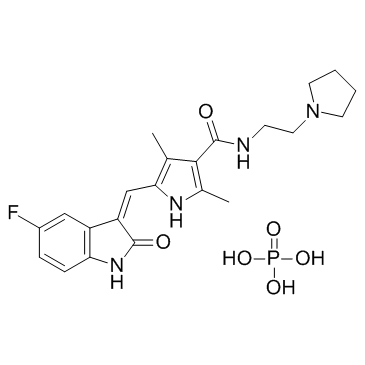874819-74-6
| Name | 5-[(Z)-(5-fluoro-2-oxo-1H-indol-3-ylidene)methyl]-2,4-dimethyl-N-(2-pyrrolidin-1-ylethyl)-1H-pyrrole-3-carboxamide,phosphoric acid |
|---|---|
| Synonyms |
UNII-24F9PF7J3R
Toceranib phosphate Palladia 24F9PF7J3R Toceranib phosphate (USAN) SU 11654 Toceranib (phosphate) |
| Description | Toceranib phosphate is a multitargeted indolinone receptor tyrosine kinase (RTK) inhibitor with Kis of 5 and 6 nM for PDGFRβ and Flk-1/KDR, respectively. |
|---|---|
| Related Catalog | |
| Target |
PDGFRβ:5 nM (Ki) Flk-1:6 nM (Ki) |
| In Vitro | Toceranib (SU11654) is a selective inhibitor of the tyrosine kinase activity of several members of the split kinase RTK family, including PDGFR and Flk-1/KDR, with Kis of 5 and 6 nM, respectively[1]. To explore mechanisms of acquired Toceranib (TOC) resistance in canine MCT, three resistant sublines are generated from the Toceranib-sensitive exon 11 ITD c-kit mutant C2 cell line designated TR1, TR2, and TR3. Growth of the parental C2 cells is inhibited by Toceranib in a dose-dependent manner with an IC50 of <10 nM. In contrast, TR1, TR2, and TR3 sublines are resistant to inhibition by Toceranib (IC50> 1,000 nM). Sensitivity to three other KIT RTK inhibitors is similar to the observed resistance to Toceranib. The parental line as well as all three sublines retains sensitivity to the cytotoxic agents vinblastine (VBL) and CCNU. Following 72 hr culture in the presence of increasing concentrations of Toceranib, treatment naïve, parental C2 cells detach from the culture flask and become rounded, shrunken, and clumped with increased exposure to Toceranib. In contrast, Toceranib-induced morphologic differences are not identified in the resistant sublines[2]. |
| In Vivo | Administration of Toceranib significantly decreases the number and percentage of Treg in the peripheral blood of dogs with cancer. Dogs receiving Toceranib and cyclophosphamide (CYC) demonstrate a significant increase in serum concentrations of IFN-γ, which is inversely correlated with Treg numbers after 6 weeks of combination treatment[3]. |
| Cell Assay | The c-kit mutant canine C2 mastocytoma cell line, derived from a spontaneously occurring cutaneous mast cell tumors (MCTs), is used as the parental cell line. Cells are propagated in RPMI 1640 supplemented with 2 mM L-glutamine, 10% FBS, 100 g/mL Streptomycin, and 100 U/mL Penicillin in a 37°C incubator under a humidified atmosphere of 5% CO2. Toceranib-resistant C2 cells are selected by growing C2 cells in concentrations of Toceranib ranging from 0.02 uM to 0.3 uM and increasing in 0.025-0.05 uM increments. Three independent, Toceranib -resistant sublines are established over a period of 7 months[2]. |
| Animal Admin | Dogs[3] Fifteen client-owned dogs with advanced tumors are used. Dogs receive Toceranib at 2.75 mg/kg once every other day. After 2 weeks, oral cyclophosphamide (CYC) is added at 15 mg/m2 daily. Numbers of Treg and lymphocyte subsets are measured in blood by flow cytometry during the 8-week study period. Serum concentrations of IFN-γ are measured by ELISA. |
| References |
| Molecular Formula | C22H28FN4O6P |
|---|---|
| Molecular Weight | 494.45300 |
| Exact Mass | 494.17300 |
| PSA | 171.78000 |
| LogP | 2.75810 |
| Storage condition | -20℃ |


